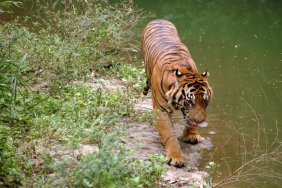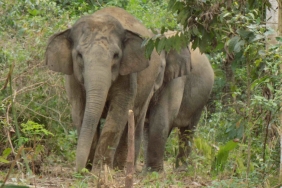POACHING IS NOT THE ONLY THREAT TO RHINOS
By: Nur Arinta
Rhino, a large mammal that is still a relative of ancient animals. The uniqueness of this animal is the strong horn that grows around its snout and is composed of a keratinized substance called horn. There are five species of rhinos in the world spread across Africa and Asia, and all five species have horns. Some rhinos have two horns, while others have only one horn.
Africa has two rhino species, including the Black Rhino, White Rhino (Ceratotherium simum) and Black Rhino (Diceros bicornis). While Asia has three rhino species, namely the Indian Rhino (Rhinoceros unicornis), Sumatran Rhino (Dicerorhinus sumatrensis), and Javan Rhino (Rhinoceros sodaicus). Reporting from savetherhino.org, rhino horns use their horns in several behaviors such as fighting to defend territories and protect their young, digging the ground to get water. In addition, a rhino will lose its charisma if it does not have a horn, because the horn is a source of charisma for this animal.
The source of the rhino's charisma also poses a threat to all rhinos in the world. All five rhino species in the world are now on the brink of extinction due to poaching and trade in horns to satisfy human needs. Rhino horns become valuable because of their beautiful colors when carved. The carved horns are used as accessories, prayer beads, buttons, dagger handles, hair ornaments, and others: Apart from being used for carving, rhino horn is also used as a traditional medicine that is believed to cure various diseases. The efficacy of rhino horn is believed in several countries in Asia such as Malaysia, South Korea, India and China. In China, rhino horn is shaved or crushed into powder, dissolved in hot water, then the solution is consumed to cure fever, rheumatism, gout, and become an antidote if bitten by a poisonous snake.
This myriad of believed properties makes the price of rhino horn on the international market very high. Wildlife Crime and Trade Investigator - WWF-Indonesia, Novi Hardianto said that the price of rhino horn in the international market reaches Rp. 25 million per-gram. This very high price encourages people to poach rhinos and threatens the world's rhino population.
The myriad of benefits of rhino horn described above are unfortunately untested. Until 1983, WWF International together with IUCN published the results of a pharmaceutical study that tested and proved the truth of the efficacy of rhino horn. The results of the study stated that there was no evidence at all that rhino horn had a medical effect to cure diseases. Rhino horn is composed of the protein substance keratin, the same substance that makes up human nails and hair. Dr. Arne Schiotz from WWF International said, "this proves that rhino horn has no function other than for its own owner, the rhino itself. Medically speaking, eating rhino horn is the same as eating our own nails or hair."
The poaching of rhinos for their horns is mostly experienced by African rhinos, while rhinos in Indonesia, namely Javan Rhinos and Sumatran Rhinos have other threats besides horn poaching. The Javan rhino is now experiencing problems with overpopulation within the same habitat area. This makes some of the Javan rhino population must be moved to a second habitat to survive longer. As for the Sumatran rhino, the threat of poaching still exists but is minimal. What is now a threat to the life of the Sumatran rhino is its increasingly narrow habitat due to habitat conversion into oil palm plantations, mining, and for other purposes.
Life is composed of a chain of ecosystems that are interconnected with each other. In retrospect, people who live in cities and far from forests have no connection to rhinos and other animals that live there. But we actually have a close relationship with rhinos and other animals that live in the forest. The closest thing to our connection with the ecosystem in the forest is our consumption pattern. Consumption patterns of urban communities that are not environmentally friendly will have an indirect impact on the balance of the ecosystem, such as the consumption of palm oil that is not certified as environmentally friendly, which has a negative impact on the existence of rhino and other animal habitats. This is because forests will be degraded, forests that are home to rhinos and other animals will be lost, and we will lose carbon sinks, thus accelerating global warming. That is why, we as consumers in urban areas must be wise consumers and buy products that are good and environmentally friendly. If we can be wise consumers and buy products that are good and right, then the preservation of forests and their ecosystems will be maintained.





